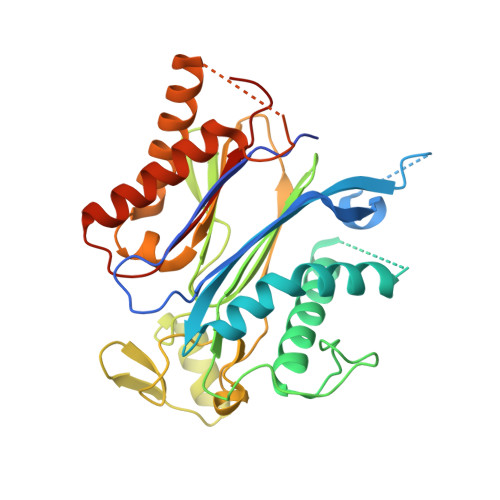A Thermodynamic Switch Modulates Abscisic Acid Receptor Sensitivity.
Dupeux, F., Santiago, J., Betz, K., Twycross, J., Park, S., Rodriguez, L., Gonzalez-Guzman, M., Jensen, M.R., Krasnogor, N., Blackledge, M., Holdsworth, M., Cutler, S.R., Rodriguez, P.L., Marquez, J.A.(2011) EMBO J 30: 4171
- PubMed: 21847091
- DOI: https://doi.org/10.1038/emboj.2011.294
- Primary Citation of Related Structures:
3ZVU - PubMed Abstract:
Abscisic acid (ABA) is a key hormone regulating plant growth, development and the response to biotic and abiotic stress. ABA binding to pyrabactin resistance (PYR)/PYR1-like (PYL)/Regulatory Component of Abscisic acid Receptor (RCAR) intracellular receptors promotes the formation of stable complexes with certain protein phosphatases type 2C (PP2Cs), leading to the activation of ABA signalling. The PYR/PYL/RCAR family contains 14 genes in Arabidopsis and is currently the largest plant hormone receptor family known; however, it is unclear what functional differentiation exists among receptors. Here, we identify two distinct classes of receptors, dimeric and monomeric, with different intrinsic affinities for ABA and whose differential properties are determined by the oligomeric state of their apo forms. Moreover, we find a residue in PYR1, H60, that is variable between family members and plays a key role in determining oligomeric state. In silico modelling of the ABA activation pathway reveals that monomeric receptors have a competitive advantage for binding to ABA and PP2Cs. This work illustrates how receptor oligomerization can modulate hormonal responses and more generally, the sensitivity of a ligand-dependent signalling system.
Organizational Affiliation:
European Molecular Biology Laboratory, Grenoble Outstation and Unit of Virus Host-Cell Interactions, UJF-EMBL-CNRS, Grenoble Cedex 9, France.


















